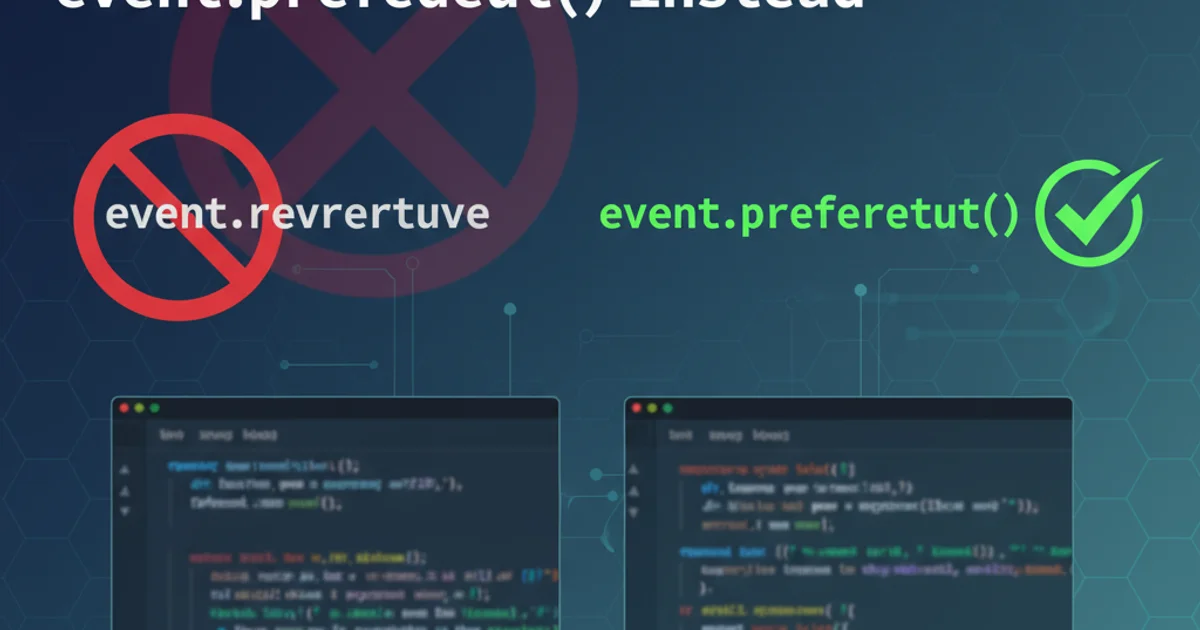event.returnValue is deprecated. Please use the standard event.preventDefault() instead
Categories:
Migrating from event.returnValue to event.preventDefault()

Understand why event.returnValue is deprecated and how to effectively replace it with the standard event.preventDefault() for robust event handling in modern JavaScript and jQuery applications.
In web development, handling events is a fundamental task. Historically, browsers offered various ways to control default event behavior. One such method, event.returnValue, was widely used, particularly in older Internet Explorer versions, to prevent the default action associated with an event. However, with the evolution of web standards and the widespread adoption of the W3C DOM Event Model, event.returnValue has been deprecated in favor of the more standardized and cross-browser compatible event.preventDefault().
Understanding the Deprecation of event.returnValue
The event.returnValue property was a non-standard way to indicate whether the default action of an event should be prevented. Setting event.returnValue = false; would stop the browser from performing its default action, such as navigating to a new page when clicking a link or submitting a form. While functional in older browsers, its non-standard nature led to inconsistencies across different browser implementations and was eventually superseded by event.preventDefault().
flowchart TD
A[User Action (e.g., Click Link)] --> B{Event Listener Triggered}
B --> C{Is `event.returnValue = false` called?}
C -->|Yes (Deprecated)| D[Default Action Prevented]
C -->|No| E{Is `event.preventDefault()` called?}
E -->|Yes (Standard)| D
E -->|No| F[Default Action Occurs]Event Default Action Prevention Flow
event.returnValue in new development or maintaining old code can lead to unpredictable behavior in modern browsers and should be avoided. Always prioritize standard APIs.The Standard Solution: event.preventDefault()
event.preventDefault() is the W3C standard method for preventing the default action of an event. When called on an event object, it stops the browser from executing its default behavior for that event. For example, calling event.preventDefault() within a click handler for an <a> tag will prevent the browser from navigating to the link's href. Similarly, for a form submission, it will prevent the form from being submitted.
// Using event.returnValue (Deprecated)
function oldClickHandler(event) {
// Some logic
if (someCondition) {
event.returnValue = false; // Prevents default action
}
}
// Using event.preventDefault() (Standard)
function newClickHandler(event) {
// Some logic
if (someCondition) {
event.preventDefault(); // Prevents default action
}
}
Practical Migration Steps and Considerations
Migrating from event.returnValue to event.preventDefault() is generally straightforward. The key is to identify where event.returnValue = false; is used and replace it with event.preventDefault();. This applies to both vanilla JavaScript and jQuery event handlers.
Vanilla JavaScript
// Old code (potentially in older browsers)
document.getElementById('myLink').onclick = function(event) {
// Do something
if (event.ctrlKey) {
event.returnValue = false; // Deprecated
}
};
// New code (standard)
document.getElementById('myLink').addEventListener('click', function(event) {
// Do something
if (event.ctrlKey) {
event.preventDefault(); // Standard
}
});
jQuery
// Old jQuery code (might have worked due to jQuery's normalization)
$('#myForm').submit(function(event) {
// Do validation
if (!isValid) {
event.returnValue = false; // Deprecated, though jQuery often normalizes
}
});
// New jQuery code (standard and recommended)
$('#myForm').submit(function(event) {
// Do validation
if (!isValid) {
event.preventDefault(); // Standard
}
});
// Alternative for jQuery: return false
// jQuery's event system automatically calls preventDefault() and stopPropagation()
// if a handler returns false.
$('#myOtherLink').click(function() {
// Do something
return false; // Equivalent to event.preventDefault() and event.stopPropagation()
});
false from an event handler is a common shortcut that calls both event.preventDefault() and event.stopPropagation(). Be mindful of this behavior, as you might not always want to stop propagation.For AJAX requests, event.preventDefault() is crucial when submitting forms asynchronously. Without it, the form would perform a traditional page reload, defeating the purpose of AJAX.
```javascript
// Example with AJAX form submission
$('#ajaxForm').submit(function(event) {
event.preventDefault(); // Prevent default form submission
const formData = $(this).serialize();
$.ajax({
url: '/api/submit-data',
type: 'POST',
data: formData,
success: function(response) {
console.log('Data submitted successfully:', response);
// Update UI or show success message
},
error: function(xhr, status, error) {
console.error('Error submitting data:', error);
// Show error message
}
});
});